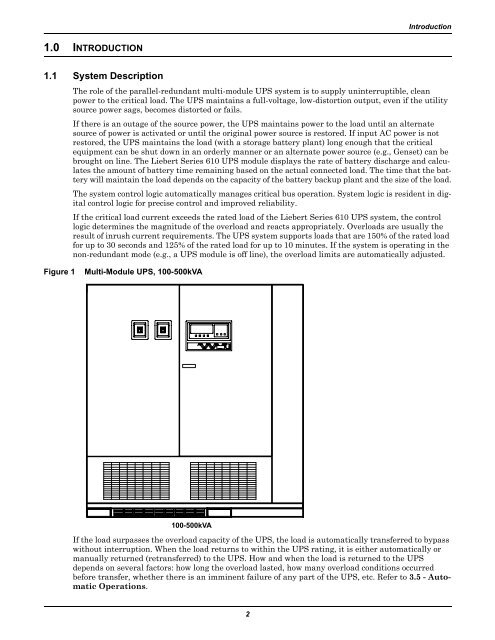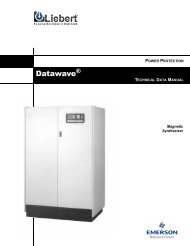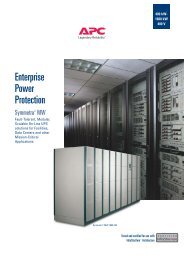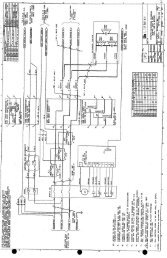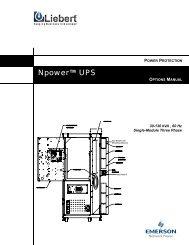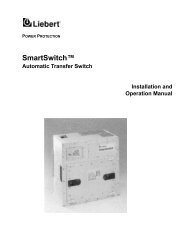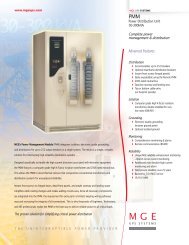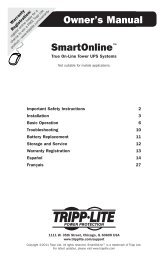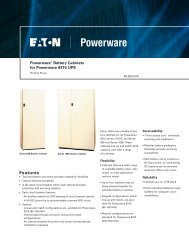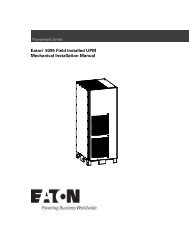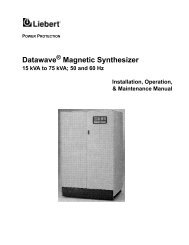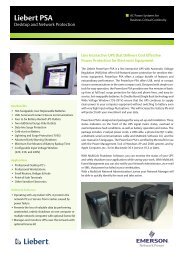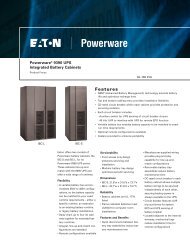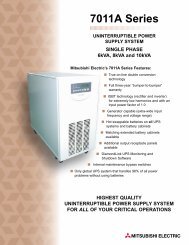Liebert® Series 610™ UPS - Jonweb.net
Liebert® Series 610™ UPS - Jonweb.net
Liebert® Series 610™ UPS - Jonweb.net
You also want an ePaper? Increase the reach of your titles
YUMPU automatically turns print PDFs into web optimized ePapers that Google loves.
Introduction<br />
1.0 INTRODUCTION<br />
1.1 System Description<br />
The role of the parallel-redundant multi-module <strong>UPS</strong> system is to supply uninterruptible, clean<br />
power to the critical load. The <strong>UPS</strong> maintains a full-voltage, low-distortion output, even if the utility<br />
source power sags, becomes distorted or fails.<br />
If there is an outage of the source power, the <strong>UPS</strong> maintains power to the load until an alternate<br />
source of power is activated or until the original power source is restored. If input AC power is not<br />
restored, the <strong>UPS</strong> maintains the load (with a storage battery plant) long enough that the critical<br />
equipment can be shut down in an orderly manner or an alternate power source (e.g., Genset) can be<br />
brought on line. The Liebert <strong>Series</strong> 610 <strong>UPS</strong> module displays the rate of battery discharge and calculates<br />
the amount of battery time remaining based on the actual connected load. The time that the battery<br />
will maintain the load depends on the capacity of the battery backup plant and the size of the load.<br />
The system control logic automatically manages critical bus operation. System logic is resident in digital<br />
control logic for precise control and improved reliability.<br />
If the critical load current exceeds the rated load of the Liebert <strong>Series</strong> 610 <strong>UPS</strong> system, the control<br />
logic determines the magnitude of the overload and reacts appropriately. Overloads are usually the<br />
result of inrush current requirements. The <strong>UPS</strong> system supports loads that are 150% of the rated load<br />
for up to 30 seconds and 125% of the rated load for up to 10 minutes. If the system is operating in the<br />
non-redundant mode (e.g., a <strong>UPS</strong> module is off line), the overload limits are automatically adjusted.<br />
Figure 1<br />
Multi-Module <strong>UPS</strong>, 100-500kVA<br />
100-500kVA<br />
If the load surpasses the overload capacity of the <strong>UPS</strong>, the load is automatically transferred to bypass<br />
without interruption. When the load returns to within the <strong>UPS</strong> rating, it is either automatically or<br />
manually returned (retransferred) to the <strong>UPS</strong>. How and when the load is returned to the <strong>UPS</strong><br />
depends on several factors: how long the overload lasted, how many overload conditions occurred<br />
before transfer, whether there is an imminent failure of any part of the <strong>UPS</strong>, etc. Refer to 3.5 - Automatic<br />
Operations.<br />
2


